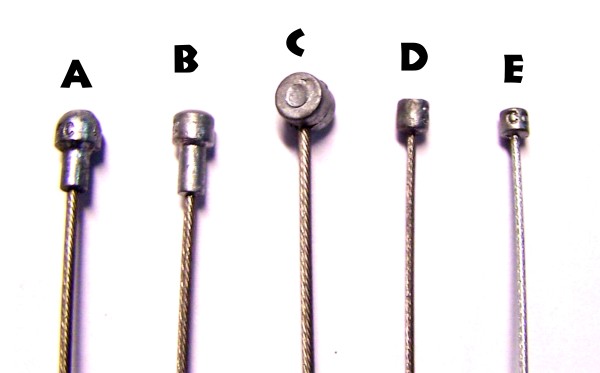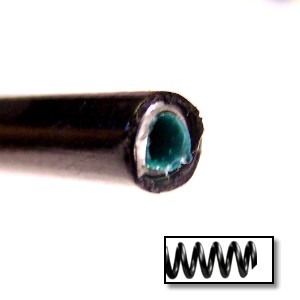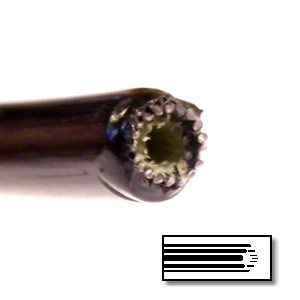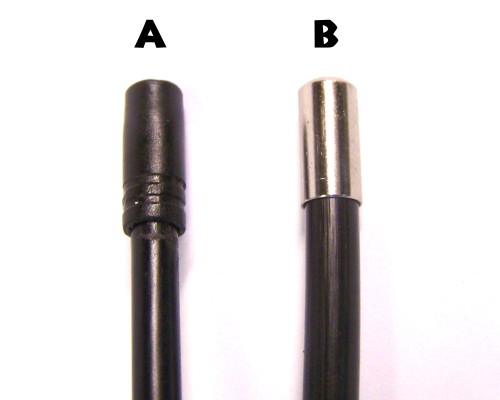Cables and Housing
by Bikeman • July 20, 2022
With the rise of electronic shifting and hydraulic disc brakes it would seem that cables are a thing of the past but there are still thousands of bikes built every year that rely on cables not to mention the millions on the planet still in service that use cables. Brakes, shifters, Campy, Shimano/SRAM - cables come in many flavors. Too often overlooked when setting up a drivetrain; cables and housing can be the major cause of miss-shifting and heavy shifter feel. Here is a basic run-down on the ins and outs of bicycle cables.
Cables
Brake cables are thicker, typically 1.5/1.6mm in diameter. Brake cables come with a choice of three different heads - one for mountain/flat bar brake levers, one for Shimano/SRAM road/drop bar brake levers (also compatible with most non-Shimano/SRAM road/drop bar brake levers except Campagnolo), and one for Campagnolo road/drop bar brake levers. A Shimano/SRAM road/drop bar brake cable head is slightly larger than a Campy head so it may not fit into a Campy road brake.
Derailleur cables are thinner, 1.1/1.2mm in diameter. There are two heads available on derailleur cables - Shimano/SRAM and Campagnolo. A Shimano/SRAM cable head is slightly larger than a Campy head so it may not fit into a Campy shifter.

A. Shimano/SRAM Road/Drop Bar Brake Cable
B. Campagnolo Road/Drop Bar Brake Cable
C. Mountain Brake Cable
D. Shimano/SRAM Shifter Cable
E. Campagnolo Shifter Cable
Housing
Just like with cables, housing comes in two different types; brake and shifter. From the outside they may look the same - but they are in fact very different.
Brake housing is built around a wire that coils down the length of the cable. This structure gives the great strength needed for the power generated by the brake lever.

Shifter cables see different forces so the housing is built differently. Shifter housing is built around many length-wise running cables that make the housing 'compressionless' which aids in the crisp feel of shifting - especially needed on today's 10/11/12 speed drivetrains.

Shifter housing also comes in two different outside diameters, 4mm and 5mm. New bikes and shifter sets typically come with 4mm housing. Most of this OEM 4mm housing will have plastic ferrules at the ends while 5mm housing uses brass ferrules. Historically here at Bikeman we recommended using 5mm shift housing, especially on MTB drivetrains as it allows a little extra room for the cable to move freely inside the housing especially if contamination finds its way in. The brass ferrules are also not prone to the splitting that plastic ferrules are which results in frayed housing. In more recent years however with increase in frames designed for full length housing and cable ports that will only fit 4mm housing that option is not always available. Luckily there have also been improvements in housing construction that keep the cable running smoothly and the development of aluminum 4mm ferrules that eliminate the failure of OEM plastic ferrules. We feel one of the best upgrades you can make right away on a new bike is to swap out OEM 4mm plastic ferrules for aftermarket 4mm aluminum ferrules.

A. 4mm Housing with Plastic Ferrule
B. 5mm Housing with Brass Ferrule
Other variations of housing include housing made from many aluminum segments. On the positive side the aluminum housing is stiff, lightweight, and reusable. On the negative side there is a lot more set up time, cost and care must be taken to be sure that the frame is protected as aluminum housing will rub paint off quickly where it contacts the frame.
Please Note: Due to their construction, brake housing should always be used with brakes and shifter housing should always be used with shifters. Shifter housing could fail if used on a brake (not good when you want to stop) and brake housing could make that shifter feel a little dead.
Bikeman's Cable Recommendations
As I mentioned earlier, cables are far too often an afterthought when setting up a drivetrain and an easy place to skimp out on. Cables aren't all created equal. A good quality cable can really improve the feel and action of your shifter or brake. In the store we prefer slick stainless cables. The 'slick' part of that refers to a process in which the cable is drawn through a circular die that smooths out the braids on the outside of the cable. The stainless part refers to stainless steel meaning the cable won't (or shouldn't) rust. A couple extra dollars spent on a cable like this is well worth it.
So there you have it, the nuts and bolts of cable and housing. Whether your bike has been in your stable for years or it's brand new, check out the type/condition of the housing, cables and ferrules. A high quality housing paired with slick stainless cables and metal ferrules will always improve the shifting and braking performance.
